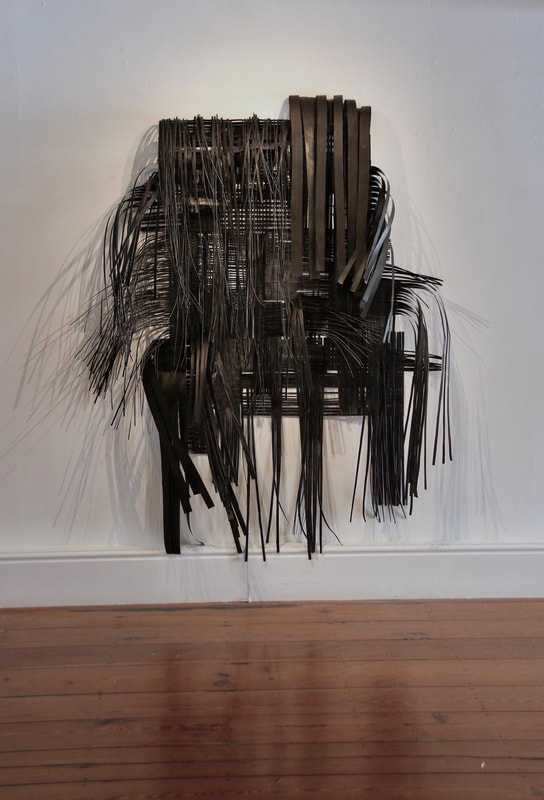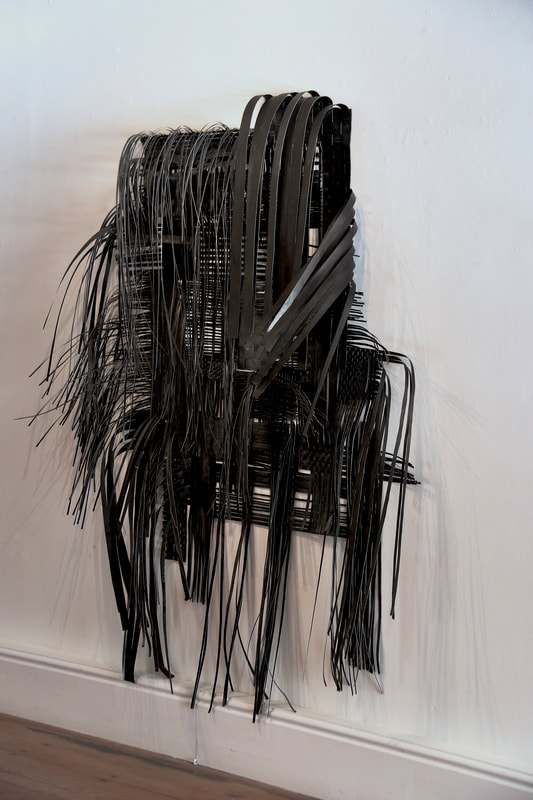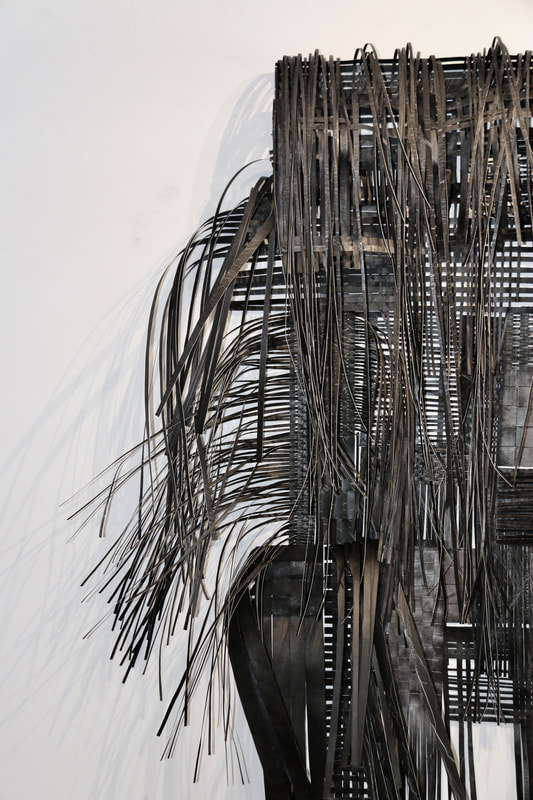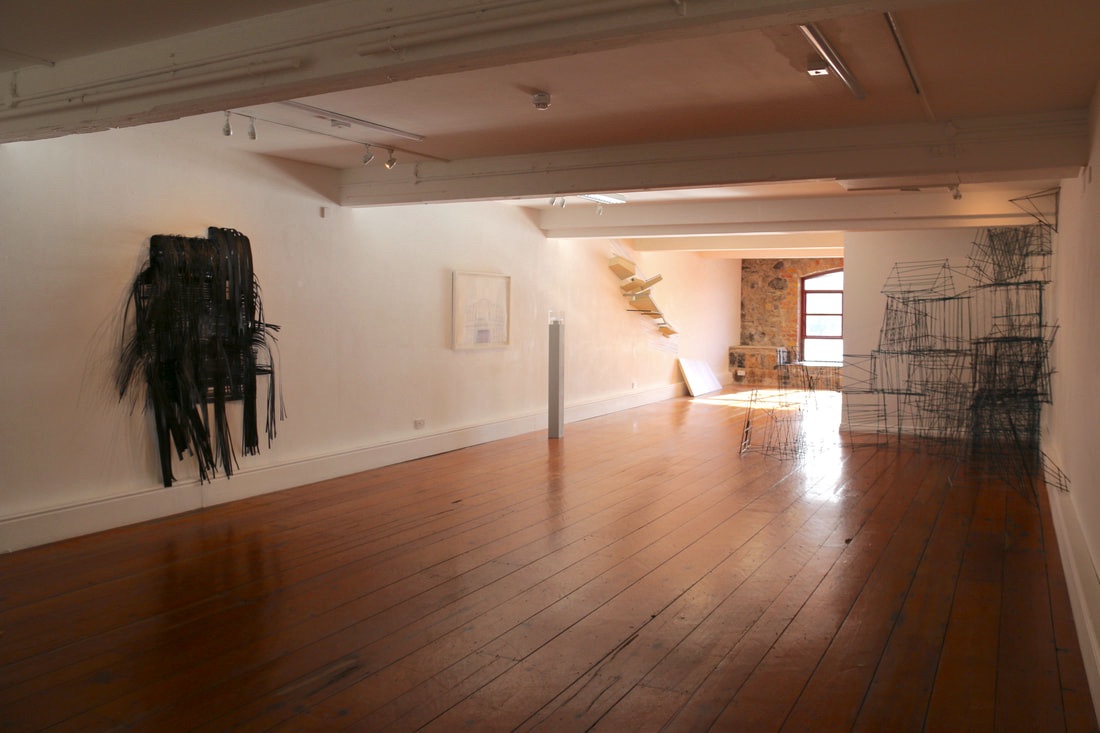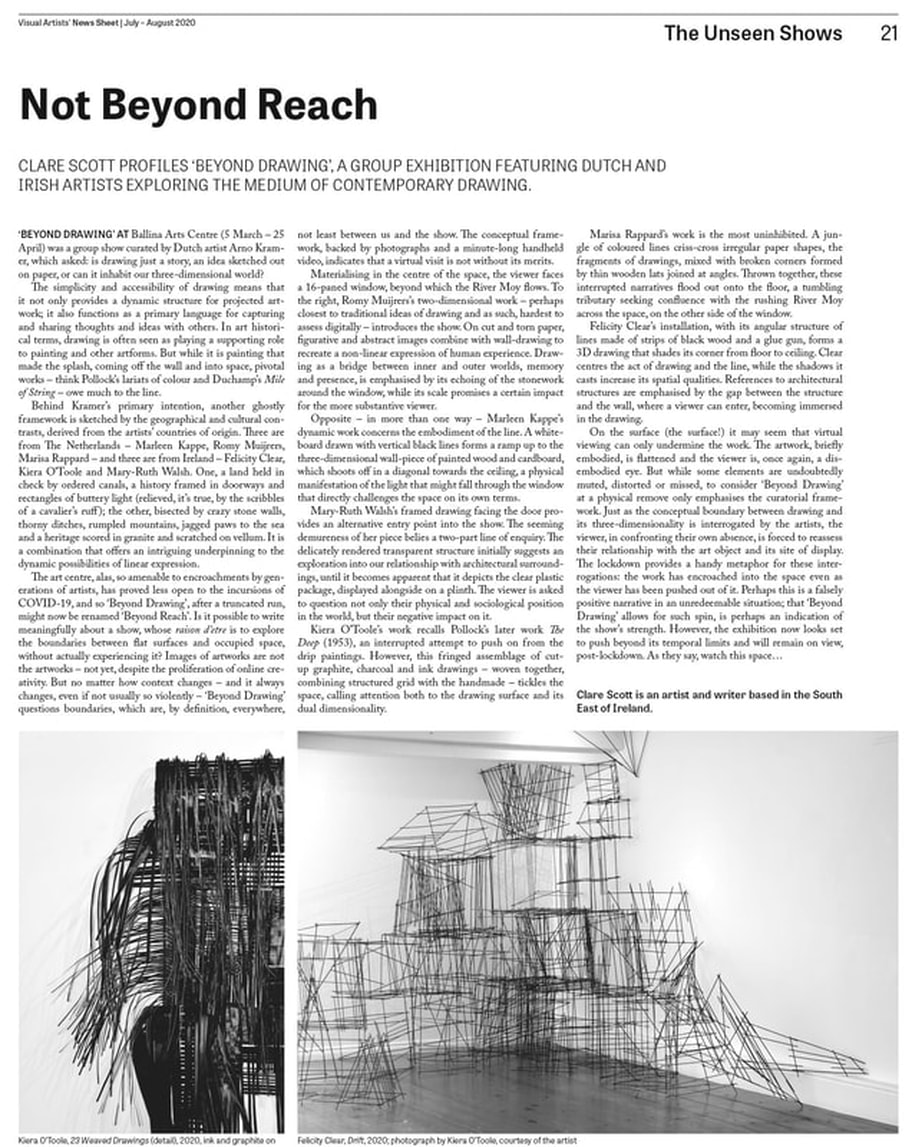B E Y O N D D R A W I N G
Arno Kramer
It is tree years ago now that I was invited by Sean Walsh to curate an exhibition of drawings from Dutch artists, who all have worked in Ballinglen Arts Foundation as artists in residence. Because of this Dutch chain of people I called the show HUMAN CHAIN, after a poem of the Irish poet Seamus Heaney. The drawing exhibition was indeed just about drawings, most of the works were put directly on the wall with pushpins, without frames, so that you, as visitor, have the best experience in looking at the drawings.
After taking down the show Sean Walsh did ask me if I could think about a new exhibition project here in Ballina Arts Centre. I was already for a longer time thinking about what a drawing is, is it just a work on paper, or can you say that artists are so free at this very moment that the drawing develops in a more three dimensional direction…and see what happened.
In 2016 I was invited by Visual Artists Ireland to do a peer critique in Dublin and at that time there were six Irish artists selected for me to work with for one day and to talk about their represented drawings. The connection between the six artists was so good that they have started a cooperation called Drawing DeCentred as new initiative. When I was thinking about the idea of Beyond Drawing, looking for ‘borders’ in drawing, I immediately thought of DrawingDeCentred,our good contact and maybe more important their good works. I have asked all six artists to come with a proposal for Beyond Drawing and finally choose Felicity Clear, Mary-Ruth Walsh and Kiera O’Toole. I did have already three Dutch artists in my mind, Marisa Rappard, Marleen Kappe and Romy Muijrers, and this is finally Beyond Drawing. The exhibition will also travel to Uillinn West Cork arts Centre in July this year.
However it is still normal to say that the line makes the drawing, it is obvious that in these days there is happening a lot more than making just drawings on paper with classical materials like charcoal, pencil and ink. At this very moment you can see that there is a huge necessity for artists to find out what the borders of drawing can be. First for example by working with different materials, even with smoke on paper, no rectangle form of the paper, but also in the way of presentation. The drawing or the way of drawing is more used as tools to make what you can call an installation. Sometimes indeed with the linear aspect of a drawing as a starting point. Question is: can you speak of three-dimensional drawings? And what is a three-dimensional drawing?
Artists are working in their own visual language and technic, but they use that free and very emphatically. Charcoal, pencil and ink have been supplemented with other materials like iron wire, tape, wood and even photography, which means that drawings move up in the direction of sculpture. Is it getting a sculpture? And why would you choose such a way of working? Is it the best way to express yourself? Or is it a new direction in finding out if beauty is the mean thing?
Every artist chosen for Beyond Drawing did find a very outspoken way of working. For my as curator of this show the original quality of work is the key point to make choices for artists. Authenticity, sensitivity, craftsmanship are also very important to convince the choice of these six artists.
For this exhibition Beyond Drawing Felicity Clear is presenting a site-specific installation entitled DRIFT. The making of the installation begins in the studio where individual component parts are put together intuitively much like drawing in 3D with sticks and a glue gun. The pieces might have references to architecture or urban structures, but more recently there are references to drawing itself with multiple parallel lines echoing cross-hatching drawing technique. In the gallery the individual components are stacked up to form a singular 3d drawing installation. Here in Ballina Arts Centre there is a sense that the drawing is drifting along the gallery wall and gathering in the corner where it floats up to the ceiling. The installation is not complete until it is spot lit. The shadows form part of the drawing and increase its spatial qualities. There is a gap between the structure and the gallery wall where a viewer can slip in and become immersed in the drawing.
Marisa Rappard’s work is inventive, sensitive and open. The installation is never just build up from a sketch. The place where she presents her work is important because she likes to improvise on the spot with the drawings on paper which are available. On these used paper you can see a jungle of lines, also the form of the paper is an adventure and none of them are the same, like when you draw on bought paper. When you try to discover a motif in the jumble of thousands of differently colored lines, it will not be easy. It is better to undergo the drawing first, that perception and search for a hold or for a possible form. There are forms related to reality, but you really have to search, especially installations like this one here, mainly made up of labyrinthine colored pencil lines and different forms. As your eye wanders over the sheet of paper and your lines continue to follow, a motif can suddenly appear that is very emphatically incorporated into the complexity of the drawn lines. The "discovery" of a motif provides an opportunity to take a deep breath and continue the search.
Kiera O’Toole is always searching for the best way and place to make her work and to present her work. She works in her studio but also in the country, uses white crayon to make patrons, on stones, on walls. The final result can be a video. Her studio work is strong. Surface forms the starting point for her drawing practice. The scale, texture and structure of a surface forms and informs the drawing. In this work, the perception of 23 drawings, some are 10 years old, are interrupted by cutting up and individually weaving and collating them together to shape a larger drawing. Using conventional drawing materials as graphite, charcoal and ink on paper, the drawing(s) evoke assemblage art rather than a traditional 2D drawing. Taking an intuitive and non-craft like approach to weaving, the drawing(s) retain a sense of the hand(made) and extend into three dimension. This approach calls attention to the significance of the drawing surface.
Marleen Kappe, who is not here because she just has giving birth to her first baby, is a very delicate drawer. Most of her works are starting on paper and then she is searching literally for more space and makes objects coming from the wall. The installation is complex but also delicate and visually strong. In her work you can see indeed lots of drawn lines. She is so free in her works on paper that she can ‘search’ over the last years for more three-dimensional solutions as well. However there is mostly the line as a starting point, her focus is also on for her relevant forms, like billboards, combined with straights drawn lines. Not only in her forms she is always looking for new elements, but also in the use of different materials. The 3D elements can be made by herself from wood and painted over. Lines can be constructed with metal or tubes. Everything in the installations gets the specific Marleen Kappe touch. There is a certain tension in her work, but it never feels like a chaos or uncontrolled. In the drawn lines there is a lot of sensitivity, it is in delicate balance with the more three-dimensional cut out forms.
Romy Muyrers is maybe the most close with her work to the real drawing on paper. But she also rips and cuts out forms of paper and installs these with other forms and lines on the wall. Her handwriting is very recognizable and delicate. Elements from reality are combined with more abstract searching lines and forms. Romy Muijrers drawings are, as she said it herself, a search for an inner time. The title of a series of works is “In Search of Lost Time”, borrowed from Marcel Proust. She can and wants to make work that is spurred on by an intense desire for something or someone. A returning to lost moments, to relive memories and let them grow as images into the drawings. During her work, she follows certain patterns, which she calls “Species of Spaces”. By using shapes, lines and hatchings, memories take shape in the drawings. She observes how time affects her surroundings. She feels that clock time often changes the space around her. Everywhere she goes, she carries ‘a mirror of the past’ with her as she said, because it enables her to find a way back to memories and desires. Paper is still an important medium, because she can cut it or rip it in certain forms.
Mary-Ruth Walsh practice explores buildings from frenetic shopping centres to the desolate loneliness of empty spaces and how architecture affects the way we move and behave in the urban environment. Architecture is in her opinion part of our identity. She explores her work and vision in drawing, painting, film-making, sculpture-installation, critical writing and occasionally performance. Mary-Ruth Walsh is a delicate drawer, but wants to do more than just working on paper. Nothing is in fact impossible in her work as material, however what she draws is very outspoken. She is very keen on forms, and these forms can come from very ordinary things like plastic or cardboard trays. When you blow these forms even up, you can see buildings in it. But a certain delicacy in the drawings on paper is her strength as well.
So here in all these works is an appeal to our illusion, to our imagination, and perhaps we can blend into the surreal world that is being sketched. Openings enough, images enough. Meetings on different levels are near I assumed. These are encounters at different levels and ways. We see each other, talk to each other, we look at works, compare works, enjoy these works hopefully. it. There are always encounters, other encounters. The meeting was also delicate, namely with our first visual touch of materials, and the artist who has felt the material before and moved with it. Meetings again. With every glance, with every touch. Our gaze meets another, meets these artworks, meets the landscape, a skyline or the clouds. A hand moves and touches another hand, a hand draws, may later touch a glass, a flower or a letter. Somewhere a pen passes over the paper, someone draws with charcoal, scratches, polishes and erases. The artwork is progressing, the material is calling, the form is screaming, an image is created, mysterious, fragile, unruly, sensitive, clear. Everything is constantly moving in our mind and in our feelings. The artists have sometimes completed hundreds of encounters on paper, on wood, on metal. Small touches, sometimes even violent touches, or sensitive touches, but always animated and charged.
In the poem Human Chain, Seamus Heaney writes in the last sentences:
A letting go which will not come again
Or it will, once. And for all.
You can say that the participating artists here have done it: a letting go. I will hope that it will come again. It will already in Skibbereen.
Indeed for all.
Arno Kramer
B E Y O N D D R A W I N G
Arno Kramer
However it is still normal to say that the line makes the drawing, it is obvious that in these days there is happening a lot more than making just drawings on paper with classical materials like charcoal, pencil and ink. At this very moment you can see that there is a huge necessity for artists to find out what the borders of a drawing can be. First for example by working with different materials, even smoke, water, air, no rectangle form of the paper, but also in the way of presentation. The drawing or the way of drawing is more used as tools to make what you can call an installation. Sometimes indeed with the linear aspect of a drawing as a starting point. Question is: can you speak of three-dimensional drawings? And what is a three-dimensional drawing?
Artists are working in their own visual language and technic, but they use that free and very emphatically. Charcoal, pencil and ink have been supplemented with other materials like iron wire, tape, wood and even photography, which means that drawings move up in the direction of sculpture. Is it getting a sculpture? And why would you choose such a way of working? Is it the best way to express yourself? Or is it a new direction in finding out if beauty is the mean thing?
Every artist chosen for Beyond Drawing did find a very outspoken way of working. For my as curator of this show the original quality of work is the key point to make choices for artists. Authenticity, sensitivity, craftsmanship are also very important to convince the choice of these six artists.
Indeed mostly starting with an ‘ordinary’ drawing or sketch the work develops in a more three-dimensional direction, because the artist takes risks, would like to find out if there are borders not obstruct for example by the size of the paper. Not even obstruct by any material. Very often is the restriction of the drawing installation the size of the space. Every artwork has something in itself like an own time, suggesting it to us.
Every piece of art is beside that it can keep beauty in itself, call for emotions, tell something about the world around us, of the individual feeling from the maker, also direct and always a reminder.
Arno Kramer 2020
Artists:Felicity Clear (IRL), Marleen Kappe (NL), Romy Muijrers (NL), Marisa Rappard (NL), Kiera O’Toole (IRL), Mary-Ruth Walsh (IRL)
PRESS RELEASE
